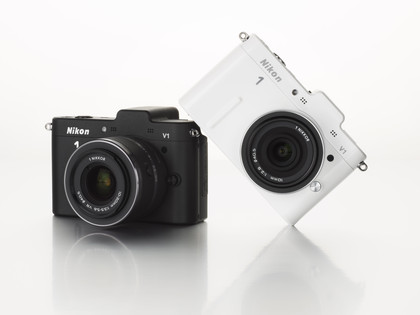Why you can trust TechRadar

Because of the electronic viewfinder (EVF) on top of the Nikon V1, it's bigger than the J1. But it has the same control arrangement and - with the obvious exception of the choice of screens for composing and reviewing images - the Nikon V1 handles in a very similar way to the J1.
Although the Nikon V1 uses a smaller sensor than Micro Four Thirds cameras, this doesn't give any size advantage. If you want a really small camera then the Pentax Q could be the way to go – it's tiny, but it has a compact camera-sized sensor to match.
Like the Nikon J1, the V1 is minimalist and uncomplicated, with a fairly limited collection of controls on its back and top-plate. The magnesium alloy body has a high-quality feel, and the only weak point appears to be the rotating multi-controller dial (on the back of the camera), which feels insubstantial and loose when you rotate it.
There are two ways to start up the Nikon V1 when the Nikkor 10-30mm f3.5-5.6 VR collapsible lens is mounted. When the lens is collapsed, pressing the lens button and rotating the zoom ring extends the optic and brings the camera to life in a little under two seconds. Alternatively, pressing the on/off button on the top-plate activates the camera in around a second.

Although it's disappointing that the advanced PASM exposure modes can only be selected via the menu when the mode dial is set to Still Image mode (denoted by a green camera icon), most photographers tend to shoot in one mode, for example Aperture Priority, most of the time. Novice photographers can set the camera to Scene Auto Selector mode via the menu, or use the mode dial to set it to Smart Photo Selector.
In Scene Auto Selector mode, the Nikon V1 chooses settings that it calculates are correct for the scene, be it a portrait or a landscape, for example. It's unusual that there's no option to specify the type of scene being photographed to give photographers a semblance of control.
Smart Photo Selector is an evolution of Nikon Best Shot Selector. When this mode is selected, the Nikon V1 starts recording to the buffer as soon as the shutter release is depressed halfway, and an icon displays in the LCD that lets you know recording has begun. When the shutter release is pressed home, a shot is recorded, and the camera compares it with the frames captured in the buffer.
Sign up for breaking news, reviews, opinion, top tech deals, and more.
The Nikon V1 then selects what it calculates are the best five shots, based on composition and sharpness, and saves them to the memory card (SD/SDHC/SDXC). This can be useful and appears effective, but the camera is tied up with processing and comparing the images for a couple of seconds after shooting.

In Shutter and Aperture Priority modes, exposure is changed using a small switch that protrudes from the back of the camera, just above the mode dial. In manual mode this switch is used in combination with the multi-control dial below the thumb rest. Both controls are quick and easy to use.
When the AF-area mode is set to Single-Point or Subject Tracking (via the menu), the active AF point is selected by pressing the OK button at the centre of the multi-control dial, then using the navigation controls to set the desired spot. It's easy, but given the number of touchscreens that are appearing on the market, we're disappointed that the Nikon V1 doesn't have a touchscreen to enable faster, more intuitive AF point selection.
The Nikon V1 has a 3-inch 920,000 dot LCD screen that provides a clear view of the scene being composed even in quite bright light. Although the screen's viewing angle is very wide both vertically and horizontally, part of it is obscured by the EVF when viewed from above. An articulated screen would make shooting from awkward angles easier.
Electronic levels are becoming commonplace in cameras, but neither the Nikon V1 or J1 has one, so the photographer must use the grid display as a guide to get the horizon level. As it has a hotshoe, it may be possible to get a bubble level with the correct fit at some point in the future.
Like the Nikon J1, the V1 enables specific sensitivity settings to be set via its menu. Alternatively, there are three automatic settings, with ranges ISO 100-3200, ISO 100-800 and ISO 100-400. These options are very useful when light levels keep changing, and the Nikon V1 can generally be relied on to choose the lowest possible option at the selected exposure settings.
